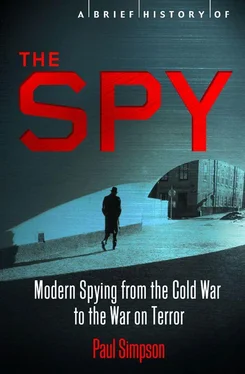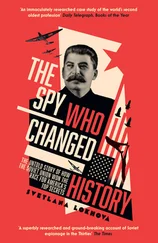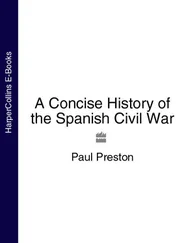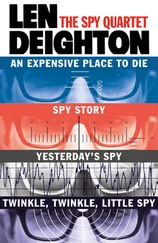Paul Simpson - A Brief History of the Spy
Здесь есть возможность читать онлайн «Paul Simpson - A Brief History of the Spy» весь текст электронной книги совершенно бесплатно (целиком полную версию без сокращений). В некоторых случаях можно слушать аудио, скачать через торрент в формате fb2 и присутствует краткое содержание. Город: London, Год выпуска: 2013, ISBN: 2013, Издательство: Constable & Robinson, Жанр: Прочая документальная литература, на английском языке. Описание произведения, (предисловие) а так же отзывы посетителей доступны на портале библиотеки ЛибКат.
- Название:A Brief History of the Spy
- Автор:
- Издательство:Constable & Robinson
- Жанр:
- Год:2013
- Город:London
- ISBN:9781780338910
- Рейтинг книги:3 / 5. Голосов: 1
-
Избранное:Добавить в избранное
- Отзывы:
-
Ваша оценка:
- 60
- 1
- 2
- 3
- 4
- 5
A Brief History of the Spy: краткое содержание, описание и аннотация
Предлагаем к чтению аннотацию, описание, краткое содержание или предисловие (зависит от того, что написал сам автор книги «A Brief History of the Spy»). Если вы не нашли необходимую информацию о книге — напишите в комментариях, мы постараемся отыскать её.
A Brief History of the Spy — читать онлайн бесплатно полную книгу (весь текст) целиком
Ниже представлен текст книги, разбитый по страницам. Система сохранения места последней прочитанной страницы, позволяет с удобством читать онлайн бесплатно книгу «A Brief History of the Spy», без необходимости каждый раз заново искать на чём Вы остановились. Поставьте закладку, и сможете в любой момент перейти на страницу, на которой закончили чтение.
Интервал:
Закладка:
The official remit of Phoenix was:
… the collection of intelligence identifying these members; inducing them to abandon their allegiance to the VC and rally to the government; capturing or arresting them in order to bring them before province security committees or military courts for lawful sentencing; and as a final resort, the use of reasonable force should they resist capture or arrest where failure to use such force would result in the escape of the suspected VCI member or would result in threat of serious bodily harm to a member or members of the capturing or arresting party.
The problem was that there were many occasions where those carrying out the Phoenix program went beyond their orders, leading to the belief that Phoenix was a cover for assassination (although obviously there was a grey area between targeted kills of Viet Cong operatives and assassinations.) Interrogations could be brutal — K. Barton Osborn, who was connected to Phoenix in 1968, described the techniques in graphic detail to a Congress subcommittee in 1971, and called Phoenix a ‘sterile depersonalized murder program… I never knew an individual to be detained as a VC suspect who ever lived through an interrogation.’
The CIA wanted to pull out of the program and leave it in South Vietnamese hands as early as 1969, in part because it didn’t really fit with their intelligence-gathering mission any more. The program was run by William Colby, who had been Chief of Station in Saigon; it officially came to an end shortly after he returned to Washington as Executive Director of the CIA in 1971 and Congress began investigating the abuses. As far as Colby was concerned, despite the problems that he acknowledged had occurred, it was a success; as he explained in a 1981 television interview: ‘I have heard several references to North Vietnamese and South Vietnamese communists who account, who state that in their mind the most, the toughest period that they faced in the whole period of the war from 1960 to 1975 was the period from 1968 to ’72 when the Phoenix Program was at work.’
The CIA was instrumental in assisting with information about prisoners of war being held during the Vietnam War. Future Vice-Presidential candidate James Bond Stockdale (yes, that really was his name) was shot down in September 1965 and spent the next seven years as a prisoner. During that time he developed a code that he used in letters home to his wife, which gave the identities of some of the men held with him. US Naval Intelligence originally handled communications with Stockdale, using a letter from his wife to secretly send him invisible carbon paper — although they warned him that if he was caught, he would be treated as a spy.
Stockdale was able to send back lists of potential targets, prisoners held and information on the camp’s location, but when senior officers decided to back off from the project, noting that the POWs ‘have got it tough enough right now… The last thing we need to do is make them spies’, the Navy turned to the CIA. The Technical Service Department’s Bruce Rounds came up with a new code which Stockdale’s wife used for a letter in May 1967.
Although the communications would lead to Stockdale’s brutal torture, they continued with other POWs, allowing families to find out about the fate of their loved ones. TSD agent Brian Lipton worked at night on the project which was kept secret from all but a very few at the CIA: it remained a classified secret even after the Vietnam War ended, with Lipton persuading now Rear Admiral Stockdale not to give up all the secrets in his autobiography. It was eventually revealed in a history of the Technical Services Division published in 2008, three years after Stockdale’s death.
The other key element of the CIA’s involvement in south-east Asia was Air America, the civilian airline owned by the Agency. This carried out multiple operations supporting the tribal groups, known as the Montagnards, who lived in the highlands between Vietnam and Laos, as well as mounting missions to rescue US pilots who had been shot down in North Vietnam. Between 1962 and 1975 Air America provided support to the Royal Lao Army and was used to transport anything and everything that needed to move around the area — from live pigs and cows during a famine, to Richard Nixon himself. According to some of its pilots, it was also involved in the opium trade (an accusation that gained credence with the release of a movie in 1990); it certainly was aware of the drugs trade, but its role was assisting in fighting the war against the communists, not policing narcotics.
Air America’s own history points out that its crews were involved in many different varieties of mission:
[They] transported tens of thousands of troops and refugees, flew emergency medevac missions and rescued downed airmen throughout Laos, inserted and extracted road-watch teams, flew night-time airdrop missions over the Ho Chi Minh trail, monitored sensors along infiltration routes, conducted a highly successful photo reconnaissance program, and engaged in numerous clandestine missions using night-vision glasses and state-of-the-art electronic equipment.
As the tide of the war in Laos turned against the Americans, Air America took heavy casualties. CIA Director Richard Helms decided to shut the operation down in 1972 once the war was concluded, but the final two years of service saw twenty-three Air America personnel killed. Although the operation’s reputation has been attacked, it is still regarded by the CIA as one of its finest. A plaque to those who served was unveiled at CIA Headquarters at Langley in 1988: ‘The aircrew, maintenance, and other professional aviation skills they applied on our behalf were extraordinary. But, above all, they brought a dedication to our mission and the highest standards of personal courage in the conduct of that mission.’
8
DISHONOUR
The seventies were a time of disillusionment in the Western world. In Britain, Edward Heath’s administration struggled with industrial disputes, and his successor Harold Wilson believed that MI5 were organizing a coup against him. In America, the ignominious end of the Vietnam War came as a shock to the country’s sense of self-belief. Matters were made worse when President Richard Nixon assisted in the cover-up of a break-in at the Watergate building in Washington DC, and would have to resign two years into his second term of office rather than risk being impeached. Worries about the CIA’s links to that burglary, as well as revelations about operations apparently directed against the American people, prompted investigations into the agency’s conduct, and a great deal of dirty linen being washed in public. West Germany’s chancellor was forced to resign when his closest advisor was revealed as a Stasi spy. And at the end of the decade, the Soviet Army, assisted by the KGB, invaded Afghanistan.
Not everything was doom and gloom. The decade began with a notable coup for MI5, who were able to arrange the expulsion of a ring of Soviet agents from the UK in Operation Foot, causing a major setback to Moscow Centre’s plans, not just in Great Britain but throughout the non-Communist world. In all, 105 agents were removed, which resulted in Soviet intelligence operations being severely hampered in the UK for the rest of the seventies.
Operation Foot came about because of increasing concern on the part of MI5 through the sixties at the size of the Soviet intelligence set-up in the UK — even if some in government and the civil service seemed to think that the threat from the KGB was diminishing following the Cuban Missile Crisis. In November 1968, following pressure from MI5, the government restricted the size of the Soviet embassy, but the KGB and GRU simply added intelligence officers to the Trade Delegation. Sir Alec Douglas-Home, appointed Foreign Secretary in Ted Heath’s cabinet following the June 1970 general election, raised the issue with his counterpart, Andrei Gromyko, only to be told: ‘These figures you give cannot be true because the Soviet Union has no spies.’
Читать дальшеИнтервал:
Закладка:
Похожие книги на «A Brief History of the Spy»
Представляем Вашему вниманию похожие книги на «A Brief History of the Spy» списком для выбора. Мы отобрали схожую по названию и смыслу литературу в надежде предоставить читателям больше вариантов отыскать новые, интересные, ещё непрочитанные произведения.
Обсуждение, отзывы о книге «A Brief History of the Spy» и просто собственные мнения читателей. Оставьте ваши комментарии, напишите, что Вы думаете о произведении, его смысле или главных героях. Укажите что конкретно понравилось, а что нет, и почему Вы так считаете.












